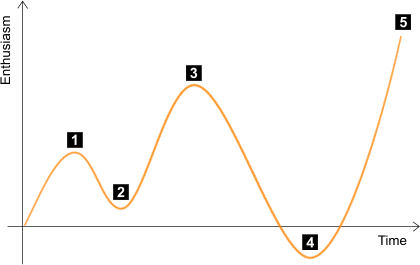How it Feels to Ship Stuff
0 comments
If you don’t know what I mean by shipping, you might want to read Real Artists (Plan to) Ship first.
Shipping is hard. It’s especially hard if you’ve never done it, or simply haven’t done it often enough to know what it feels like. You suspect that ‘inspiration’ will pull you through it, yet in reality inspiration usually doesn’t last more than a day or two.
Inspiration is an ephemeral feeling that tricks you into thinking it will always be there. Of course, it can’t be… and won’t be.
Inspiration has never shipped anything. Grit is how you ship. If you think you’re always going to be inspired and that you can just “lean on” that feeling everyday to power you, you’re going to fail. It doesn’t work. Inspiration will disappear as soon as the caffeine leaves your blood stream, you get distracted, or you wake up with a headache. You need a model for shipping, something that helps get you through the emotional dips you’re bound to experience.
When you’re inspired, you don’t expect to have dips in your motivation. You’re above that. You’re made of steel. The feeling will last forever. People who ship know better.
The art of shipping is the same the world over, no matter what the subject is. Paint, code, words, chords, clay, whatever. If you’re creating anything from nothing and expect it to see the light of day, you’re looking to ship something. Creating something without delivering it may still be considered art by some, but it’s not shipping.
When we hire new program managers at Microsoft, one of the most important things we look for is people who are good at all phases of the product cycle. We expect people to be strong at the beginning, coming up with creative ideas and unique approaches to solving tough problems. We look for strength in the middle, people who are able to execute and get the team through the grind without giving up. And we want people who can pull the team all the way through to the finish line, dealing with the (very hard) act of pushing something real out the door to a few hundred million users.
This means that the best people are the ones who can decide what to do, figure out how to do it with the team, and then start it, drive it, and ship it.
Anyone can have an idea. And just about anyone can write a strongly worded email or document about how “obvious” that idea is and how everyone who doesn’t “get it” is an “idiot”. But the people who are able to sell the idea, line the people up, and bring it all the way to the finish line, imperfections and all, and then do it over and over again are the real stars.
The funny thing is how these people usually aren’t the same people who think they’re superstars just because they have some ideas. The best people are too busy shipping to care what you think.
One of the first steps toward shipping anything is to plan to do so. But you have to be ready for the ups and downs. The emotional cycle of shipping is essential to understand, otherwise you’re going to quit with the first emotional dip.
If you can’t relate to how the “downs” of a project are going to hit you emotionally, you aren’t going to last through the peaks, valleys, and huge psychological trips you’re going to experience. Your mind is going to continually try and get you to give up. Fight or flight. So you need tools in your arsenal to push back. To think, “I know this feeling, I’ve felt it before, and I’m not going to give up on this.”
The following is a quote from Chip and and Dan Heath’s book, Switch: How to Change When Change is Hard about how IDEO, a top design firm, looks at shipping new things (emphasis mine):
Tim Brown, the CEO of IDEO, says that every design process goes through “foggy periods.” One of IDEO’s designers even sketched out a “project mood chart” that predicts how people will feel at different phases of a project.
It’s a U-shaped curve with a peak of positive emotion, labeled “hope,” at the beginning, and a second peak of positive emotion, labeled “confidence,” at the end. In between the two peaks is a negative emotional valley labeled “insight.”
Unfortunately this mood chart is nowhere to be found online. The closest thing found is from the Kanban blog which is a very similar cycle, though might overemphasize the second dip. I’ve found the reality to be pretty close to this however:
Knowledge is power, and knowing that you’re going to go through these kinds of fluctuations can help you prepare yourself or your team for them. One of my own personal tenets is that things are never as good – or as bad – as you think they are. This model emphasizes that. When you know you’re going to feel a certain way, you can get ready for it in whatever way works best for you.
But the truth is: there’s nothing better than shipping. Which is why enthusiasm runs highest at that point. Very few things compare if you consider yourself an artist of your craft.






